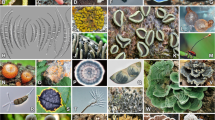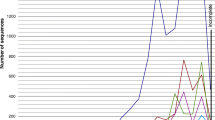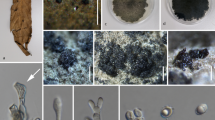Abstract
The use of molecular biology methods for identifying species of fungi and myxomycetes (DNA barcoding) has shown the necessity of reconsidering our views on the ecology and habitats of many species of spore organisms. Spores of basidiomycetes and myxomycetes can spread over considerable distances by water, wind, and insects, resulting in their resettlement to various distant habitats, where the only limiting factors are microenvironment and suitable substrates. The possibility of inhabiting various “island” habitats, for example, such as large tree debris in steppe regions or special microclimatic conditions on the bottoms of ravines and gullies in the forest steppe, where the humidity is much higher than on the plain areas, allows spore organisms to expand their habitats and settle in natural areas that are not typical for them. Our original research, an analysis of literature sources, and GenBank data have shown that, when studying the ecology and distribution patterns of spore-like organisms, issues of correctly identifying species are quiet questionable. This article discusses examples using the influence of the hypothesis Everything is everywhere, but, the environment selects (EiE hypothesis) on understanding the ecology and ranges of some species of myxomycetes and basidiomycetes. Data on the distribution and ecology of nivicolous myxomycetes Lamproderma pseudomaculatum on the plain territory of Western Siberia are presented for the first time. Using the myxomycetes Arcyria imperialis and A. stipata, as well as fungi Disciseda hyalothrix and Pleurotus pulmonarius, we envisage the possibility of a DNA barcoding application for studies of the species diversity of spore organisms and the morphological differentiation of similar species and for correctly interpreting their ranges and ecology. rDNA sequences have been studied for all these species; for myxomycetes, photos have been taken on a scanning electron microscope.











Similar content being viewed by others
REFERENCES
Adams, T.J.H., Williams, E.N.D., Todd, N.K., and Rayner, A.D.M., A species-specific method of analyzing populations of basidiospores, Trans. Br. Mycol. Soc., 1984, vol. 82, pp. 359–361.
Alexopoulos, C.J., The myxomycetes II, Bot. Rev., 1963, vol. 29, pp. 1–78.
Beijerinck, M.W., Oxidation des Mangancarbonates durch Bakterien und Schimmelpilze, Folia Microbiol., 1913, vol. 2, pp. 1–12
Blackwell, M.R., Laman, T.G., and Gilbertson, R., Spore dispersal in Fuligo septica (Myxomycetes) by lathridiid beetles, Mycotaxon, 1982, vol. 14, pp. 58–60.
Corner, E., The agaric genera Lentinus, Panus, and Pleurotus with particular reference to Malaysian species, Beih. Nova Hedwigia, 1981, vol. 69, pp. 1–169.
Erastova, D.A., Novozhilov, Yu.K., and Schnittler, M.N., Nivicolous myxomycetes of the Khibiny Mountains, Kola Peninsula, Russia, Nova Hedwigia, 2017, vol. 104, nos. 1–3, pp. 85–110.
Felsenstein, J., Confidence limits on phylogenies: an approach using the bootstrap, Evolution, 1985, vol. 39, pp. 783–791.
Finlay, B.J. and Clarke, K.J., Ubiquitous dispersal of microbial species, Nature, 1999, vol. 400, p. 828.
Fenchel, T. and Finlay, B.J., The ubiquity of small species: patterns of local and global diversity, Bioscience, 2004, vol. 54, pp. 777–784.
Fiore-Donno, A.M., Kamono, A., Meyer, M., Schnittler, M., Fukui, M., and Cavalier-Smith, T., 18S rDNA phylogeny of Lamproderma and allied genera (Stemonitales, Myxomycetes, Amoebozoa), PLoS One, 2012, vol. 7, p. e35359.
Fiore-Donno, A.M., Clissmann, F., Meyer, M., Schnittler, M., and Cavalier-Smith, T., Two-gene phylogeny of bright-spored Myxomycetes (Slime Moulds, Superorder Lucisporidia), PLoS One, 2013, vol. 8, p. e62586.
Foissner, W., Biogeography and dispersal of micro-organisms: a review emphasizing Protists, Acta Protozool., 2006, vol. 45, pp. 111–136.
Gardes, M. and Bruns, T.D., ITS primers with enhanced specificity for basidiomycetes-application to the identification of mycorrhizae and rusts, Mol. Ecol., 1993, vol. 2, pp. 113–118.
Gorbunova, I.A. and Rebriev, Yu.A., New data on the biota of gastromycetes of the Altai-Sayan mountain region, Rastit. Mir Aziat. Ross., 2016, vol. 2, pp. 3–7.
Hallenberg, N. and Kuffer, N., Long-distance spore dispersal in wood-inhabiting Basidiomycetes, Nord. J. Bot., 2001. 21, pp. 431–436.
Higgins, D., Thompson, J., Gibson, T., Thompson, J.D., Higgins, D.G., and Gibson, T.J., CLUSTAL W: improving the sensitivity of progressive multiple sequence alignment through sequence weighting, position-specific gap penalties and weight matrix choice, Nucleic Acids Res., 1994, vol. 22, pp. 4673–4680.
Keller, H.W. and Smith, D.M., Dissemination of myxomycete spores trough the feeding activities (ingestion-defecation) of an acarid mite, Mycologia, 1978, vol. 70, pp. 1239–1241.
Kumar, S., Stecher, G., and Tamura, K., MEGA7: molecular evolutionary genetics analysis versión 7.0 for bigger datasets, Mol. Biol. Evol., 2016, vol. 33, pp. 1870–1874.
Martin, G.W. and Alexopoulos, C.J., The Myxomycetes, Iowa City: Univ. of Iowa Press, 1969.
Meylan, C., Les espèces nivales du genere Lamproderma,Bull. Soc. Vaud. Sci. Nat., 1931, vol. 57, pp. 359–373.
Newton, A.F.S. and Stephenson, S.L., A beetle/slime mold assemblange from Northern India (Coleoptera; Myxomycetes), Orient. Insects, 1990, vol. 24, pp. 197–218.
Norden, B. and Larsson, K.-H., Basidiospore dispersal in the old-growth forest fungus Plebia centrifuga (Basidiomycetes), Nord. J. Bot., 2000, vol. 20, pp. 215–219.
Novozhilov, Yu.K., Myxomycetes (class Myxomycetes) of Russia: taxonomic composition, ecology, and geography, Doctoral (Biol.) Dissertation, St. Petersburg, 2005.
Novozhilov, Y.K., Schnittler, M., Vlasenko, A.V., and Fefelov, K.A., Myxomycete diversity of the Altay Mts. (southwestern Siberia, Russia), Mycotaxon, 2010, vol. 111, pp. 91–94.
Novozhilov, Y.K., Rollins, A., and Schnittler, M., Ecology and distribution of Myxomycetes, in Myxomycetes: Biology, Systematics, Biogeography and Ecology, Stephenson, S.L. and Rojas, C.A., Eds., London: Academic, 2017, pp. 253–297.
Pegler, D.N., Pleurotus (Agaricales) in India, Nepal and Pakistan, Kew Bull., 1977, vol. 31, pp. 501–510.
Pegler, D.N., Agaric flora of Sri Lanka, Kew Bull., 1986, vol. 12, pp. 1–519.
Redhead, S.A., A biogeographical overview of the Canadian mushroom flora, Can. J. Bot., 1989, vol. 67, pp. 3003–3062.
Ronikier, A. and Ronikier, M., How ‘alpine’ are nivicolous myxomycetes? A worldwide assessment of altitudinal distribution, Mycologia, 2009, vol. 101, pp. 1–16.
Shchepin, O.N., Schnittler, M., Erastova, D.A., Prikhodko, I.S., Borg Dahl, M., Azarov, D.V., Chernyaeva, E.N., and Novozhilov, Y.K., Community of dark-spored myxomycetes in ground litter and soil of taiga forest (Nizhne-Svirskiy Reserve, Russia) revealed by DNA metabarcoding, Fungal Ecol., 2019, vol. 39, pp. 80–93.
Sneath, P.H. and Sokal, R.R., Numerical Taxonomy, San Francisco: W.H. Freeman, 1973.
Stephenson, S.L., Wheeler, Q.D., McHugh, J.V.P., and Fraissinet, P.R., New North American associations of Coleoptera with Myxomycetes, J. Nat. Hist., 1994, vol. 28, no. 4, pp. 921–936.
Stephenson, S.L., Novozhilov, Y.K., and Schnittler, M., Distribution and ecology of Myxomycetes in high-latitude regions of the Northern Hemisphere, J. Biogeogr., 2000, vol. 27, pp. 741–754.
Stephenson, S.L., Schnittler, M., and Novozhilov, Y.K., Myxomycete diversity and distribution from the fossil record to the present, Biodiversity Conserv., 2008, vol. 17, no. 2, pp. 285–301.
Tamura, K., Nei, M., and Kumar, S., Prospects for inferring very large phylogenies by using the neighbor-joining method, Proc. Natl. Acad. Sci. U.S.A., 2004, vol. 101, pp. 11030–11035.
Tedersoo, L., Bahram, M., Põlme, S., et al., Global diversity and geography of soil fungi, Science, 2014, vol. 346, no. 6213, art. ID 1256688.
Tran, H.T.M., Stephenson, S.L., Hyde, K.D., and Mongkolporn, O., Distribution and occurrence of Myxomycetes on agricultural ground litter and forest floor litter in Thailand, Mycologia, 2008, vol. 100, pp. 181–190.
Vilgalys, R. and Sun, B.L., Assessment of species distribution in Pleurotus based on trapping of airborne basidiospores, Mycologia, 1994, vol. 86, pp. 270–274.
Vlasenko, A.V. and Novozhilov, Yu.K., Rare and new for Russia species of myxomycetes (Myxomycetes) of Russia from pine forests on the right bank of the Upper Ob region, Mikol. Fitopatol., 2010, vol. 44, no. 2, pp. 99–108.
Vlasenko, A.V. and Novozhilov, Yu.K., Myxomycetes of pine forests on the right-bank part of the Upper Ob’ region, Mikol. Fitopatol., 2011, vol. 45, no. 6, pp. 465–477.
Vlasenko, V.A. and Vlasenko, A.V., Wood-decay fungi on woody plants in the green plantations of the Novosibirsk, Vestn. Altai. Gos. Agrar. Univ., 2018, no. 1 (159), pp. 93–97.
Vlasenko, A.V., Novozhilov, Yu.K., Shchepin, O.N., and Vlasenko, V.A., Hydrochory as certain mode of distribution of myxomycetes along floodlands in south of Western Siberia, Mikol. Fitopatol., 2016, vol. 50, no. 1, pp. 14–23.
Vlasenko, A.V., Novozhilov, Yu.K., Vlasenko, V.A., Korolyuk, A.Yu., and Dulepova, N.A., New data on obligate coprobiontic myxomycetes of Siberia, Izv. Irkutsk. Gos. Univ.,Ser.: Biol. Ekol., 2017a, vol. 21, pp. 50–60.
Vlasenko, V.A., Vlasenko, A.V., and Zmitrovich, I.V., First record of Neolentinus lepideus f. ceratoides (Gloeophyllales, Basidiomycota) in Novosibirsk Region, Curr. Res. Environ. Appl. Mycol., 2017b, vol. 7, no. 3, pp. 187–192.
Vlasenko, A.V., Novozhilov, Yu.K., Schnittler, M., Vlasenko, V.A., and Tomoshevich, M.A., Pattern of substrate preferences of free living protists (Myxomycetes) on decaying wood, Contemp. Probl. Ecol., 2018, vol. 11, no 5, pp. 494–502.
Vlasenko, V.A., Asbaganov, S.A., and Vlasenko, A.V., Ecological diversity of some resource medicinal mushrooms of the genus Pleurotus in Novosibirsk oblast, Samar. Nauchn. Vestn., 2019a, vol. 8, no. 4 (29), pp. 34–38.
Vlasenko, V.A., Zmitrovich, I.V., and Vlasenko, A.V., Unusual monstrose form of Neolentinus cyathiformis (Gloeophyllaceae, Basidiomycota) from the Novosibirsk Region (Russia), Bot. Pac., 2019b, vol. 8, no 1, pp. 81–84.
Vlasenko, V.A., Rebriev, Yu.A., Asbaganov, S.V., Dejidmaa, T., and Vlasenko, A.V., Morphological characteristics and molecular phylogeny of Disciseda hyalothrix (Gasteromycetes) from Altai Mountains, a new record to Northern Asia, Curr. Res. Environ. Appl. Mycol., 2020, vol. 10, no. 1, pp. 34–41.
Williams, E.N.D., Todd, N.K., and Rayner, A.D.M., Characterization of the spore rain of Coriolus versicolor and its ecological significance, Trans. Br. Mycol. Soc., 1984, vol. 82, pp. 323–326.
ACKNOWLEDGMENTS
We used materials from Popov Herbarium at the Central Siberian Botanical Garden, Siberian Branch, Russian Academy of Sciences (NSK), Novosibirsk.
Funding
The work of A.V. Vlasenko on myxomycetes was carried out in accordance with a State Task of Central Siberian Botanical Garden, Siberian Branch, Russian Academy of Sciences (AAAA-A17-117012610055-3). The work of Yu.K. Novozhilov on myxomycetes was supported by Russian Foundation for Basic Research, project no. 18-04-01232-A. The work of V.A. Vlasenko on Pleurotus pulmonarius was supported by Russian Foundation for Basic Research and the Government of Novosibirsk region, project no. 18-44-543018 r_mol_a. The work of A.S. Asbaganov and T. Dejidmaa on Disciseda hyalothrix was carried out as part of the project of Russian Foundation for Basic Research and Ministry for Culture, Education, Science, and Sport of Mongolia, project no. 19-54-44002 Mong_T. Materials from the M.G. Popov Herbarium (NSK) in Novosibirsk were used.
Author information
Authors and Affiliations
Corresponding author
Ethics declarations
Conflict of interests. The authors declare that they have no conflicts of interest.
Statement on the welfare of humans or animals. This article does not contain any studies involving animals performed by any of the authors.
Additional information
Translated by T. Kuznetsova
Rights and permissions
About this article
Cite this article
Vlasenko, A.V., Vlasenko, V.A., Novozhilov, Y.K. et al. Methods and Difficulties of Identifying Species in Studies on the Ecology and Distribution Patterns of Spore Organisms. Contemp. Probl. Ecol. 13, 346–359 (2020). https://doi.org/10.1134/S1995425520040113
Received:
Revised:
Accepted:
Published:
Issue Date:
DOI: https://doi.org/10.1134/S1995425520040113
Keywords:
- Arcyria imperialis
- Arcyria stipata
- biodiversity
- Disciseda hyalothrix
- ecology
- everything is everywhere (EiE hypothesis)
- fungi
- Lamproderma pseudomaculatum
- distribution patterns
- moderate endemicity hypothesis (MEH)
- myxomycetes
- molecular biology techniques
- Pleurotus pulmonarius
- distribution
- rDNA
- scanning electron microscopy




